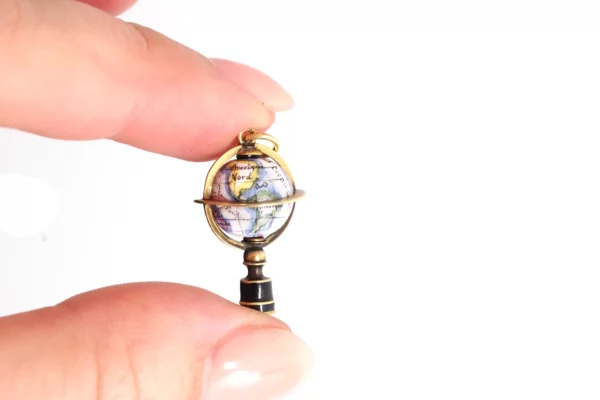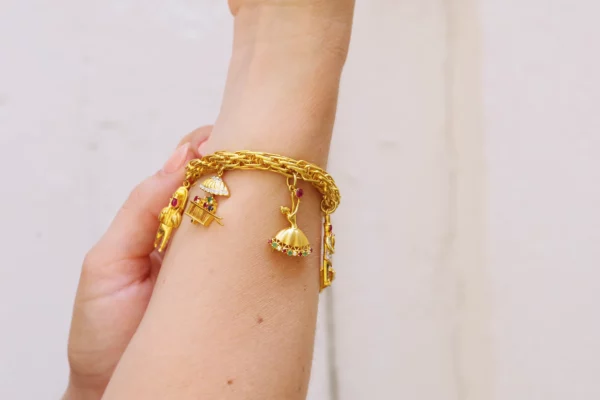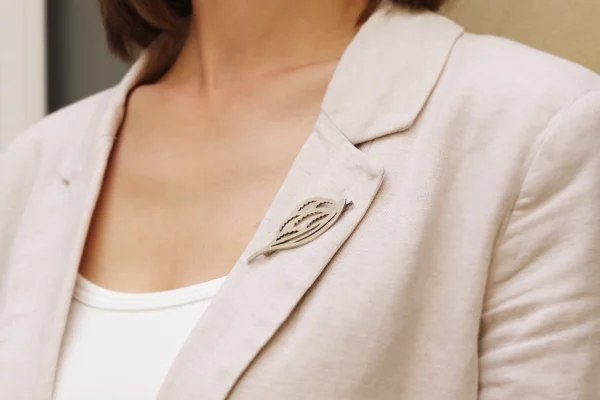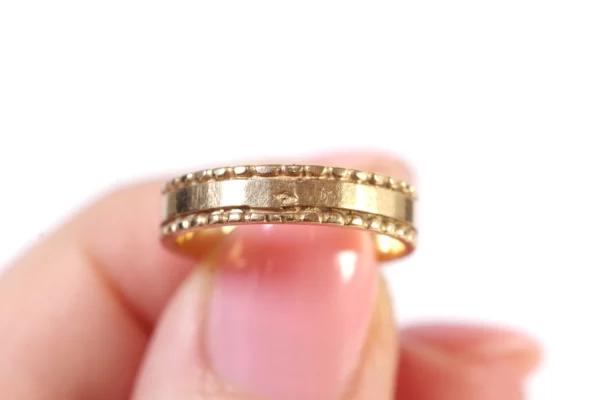Post 20th Century
215 Products
-

 1200,00€
1200,00€Art Deco onyx diamond pendant in platinum (950). An oval pendant from the Art Deco period, with a faceted onyx mounting and a mother-of-pearl plate under a rock crystal. The rock crystal is decorated with an intaglio depicting a dance allegory. : a nude woman dancing and playing with a veil. This central motif is set in a platinum surround and decorated with scrolls set with twelve rose-cut diamonds. The bezel is adorned with a ring entirely set with diamonds (on both sides). Antique pendant, circa 1930, France.
Dog head hallmark (french state hallmark for 18 karat gold)
Height (with clasp): 59 mm
Width: 29 mmCondition: slight wear scratches, the back part may have been closed with another glass.
Weight : 13.02 gr
*The antique gold chain is not sold with the jewel*
See our antique chains -

 1300,00€
1300,00€Georgian world globe charm in 18 karat and enamel. Antique pendant in the form of a globe on a black enamel base. The globe turns on itself, is enameled and represents the continents (Africa, Asia, Europe, North America, South America, New Holland), the oceans and seas (Indian Sea, Atlantic Ocean, Pacific Ocean) and the Tropic of Cancer. Antique globe pendant, circa 1830-1830, France.
Eagle head hallmark (french state hallmark for 18 karat gold) and OG or CG goldsmith’s hallmark.
Height (with bezel): 25 mm
Width: 13 mmCondition: small enamel chips
Weight : 2.12 gr
*The antique gold chain is not sold with the jewel*
See our antique chains -

 7200,00€
7200,00€Vintage Charms bracelet in 18 karat yellow gold and precious stones. Rectangular flexible mesh bracelet from the 1960s, holding seven gold charms set with precious stones:
– a ship set with brilliant-cut diamonds and calibrated synthetic rubies
– a lantern set with emeralds and brilliant-cut diamonds
– a walker with a bag on his back, his pants adorned with rubies and diamonds and his bag with an emerald, a sapphire and a ruby
– a flower cart under a parasol, the flowers figured in diamonds, rubies, emeralds, blue sapphires and yellow sapphires.
– a dancer whose dress is adorned with emeralds, diamonds and rubies
– a man in a top hat carrying a bouquet of flowers made of diamonds, sapphires and rubies.
– of a fish in a pan adorned with diamonds and rubies.
This charm bracelet dates from the 1960s.
Owl hallmark (french state hallmark for 18 karat gold)
Length: 17 cm
Mesh width: 7 mmNote: the clasp has three safety eights.
Condition: scratches from useWeight: 54.22 gr
*The antique box is not sold with the jewel*
-

 5800,00€
5800,00€Gay Freres tigers bracelet in 18 karat gold and silver. Rare band bracelet decorated with two confronting tiger heads, clasping a ring in their mouths. The body is in silver decorated with gold and black organic matter. The eyes of the two tigers are set with round rubies. The jewel opens and closes with a ratchet box and is secured with a safety eight. Gay Frères bracelet, circa 1960-1970.
Goldsmith’s hallmark Fay Frères and GOLD AND SILVER hallmark
Inside dimensions: 16 cm
Max. width 1.5 cmEstimated ruby weight: 0.08 carat
Condition : scratches from use, traces of glue
Weight : 75.06 gr
*The antique box is not sold with the jewel*
-

 1500,00€
1500,00€George Pierre Art Nouveau necklace in horn. Long Art Nouveau necklace in carved blond horn, embellished with black and ochre inks, in the shape of annual honesty plant. The pendant holds a blond horn tassel also colored black and ochre. The necklace is made of black silk ribbon decorated with two black glass beads. Art Nouveau necklace by Georges Pierre dit “GIP”, circa 1910, France.
Signed on the reverse GIP for Georges Pierre
Length: 72 cm
Design dimensions: 16 x 59 mmCondition: paint missing, scratches from use
Weight : 14.75 gr
More details : Slices of horn were dipped in hydrogen peroxide to make them translucent, then bathed in chemicals to give a shimmering sheen to the wings or a rosy sheen to the petals. The pendants, sculpted and dyed with inks, were mounted on silk ribbons, cords or chains with pastel glass beads repeating the delicate hues. Elisabeth Bonté and Georges Pierre G.I.P., initially rivals, pooled their resources and talents before producing horn jewelry until 1936, when Bakelite became the preferred material for costume jewelry.
-

 1100,00€
1100,00€Artist’s pinky ring in 18 karat gold. Vintage artist’s ring with a thick, oval, crater-like gold plate, suggesting a flattened gold nugget. The tray is in yellow gold and the ring is in slightly pinker gold. Vintage ring, circa 1960.
Owl hallmark (french state hallmark for 18 karat gold)
Finger circumference: 45 UE or 3.25 US (possible sizing)
Tray dimensions: 14 x 14 mm
Ring width: 5 mm
Condition: scratches from use
Weight : 11.18 gr
-

 1500,00€
1500,00€Raymond Templier brooch in silver. Rare brooch by Raymond Templier (1891-1968) from the 1950s, featuring an abstract motif in geometric shapes. Brooch by Raymond Templier, circa 1950/1955, France.
Signed Raymond Templier, boar hallmark, Raymond Templier goldsmith’s hallmark.
Dimensions: 25 x 61 mm
Note: a jewelry drawing on tracing paper by Raymond Templier, in the collections of the Musée des Arts Décoratifs in Paris, has a design similar to our brooch (see photo).
Condition: scratches from use
Weight : 9.51 gr
Biography: Raymond Templier (1891-1968) was a renowned French jeweler, famous for his avant-garde, modernist designs. Born into a family of jewelers, he continued his studies at the École des Arts Décoratifs in Paris, where he developed his taste for contemporary design. As a founding member of the Union des Artistes Modernes (UAM) in 1929, Templier was a pioneer of the Art Deco movement, distinguished by his geometric, streamlined jewelry. He combined metals and precious stones in innovative compositions that reflected the spirit of his age.
-


5600,00€4500,00€Retro band bracelet in 18 karat yellow and white gold. Large bracelet made of a flexible articulated mesh forming diamond-shaped motifs in white and yellow gold. Bracelet, circa 1950-1960.
Hallmark 750, hallmark “MEP”, owl hallmarks
Length: 19.5 cm
Width: 2.1 cmNote: two safety clasps on the main clasp
Condition: slight wear scratchesWeight : 62,30 gr
-

 2300,00€
2300,00€Retro French sapphire lapel clip in 18 karat gold. Cylindrical and geometric lapel clip decorated with a line of four calibrated synthetic sapphires. This lapel clip can be worn on a jacket or as a brooch. Dating from the Retro period and designed in the style of Mauboussin, it was made by Louis Heissler, circa 1935/1940 in France.
Eagle head hallmark and hallmark of the Louis Heissler workshop, which worked for Mauboussin from the 1940s to the 1960s, numbered.
Dimensions: 32 x 22 mm
Estimated sapphire weight: 0.08 carat
Condition: light scratches from use
Weight : 10.69 gr
-

 420,00€
420,00€Vintage wedding band in 18 karat rose gold. Wide gold band with faceted decoration and edged with notched friezes. Vintage wedding band, circa 1960, France.
Eagle head hallmark and owl hallmark (french state hallmark for 18 karat gold), hallmark of a silversmith active in the 1960s.
Finger size: 52 EU or 6 US
Ring width: 4 mm
Ring thickness: 1 mmNote: engraving possible inside the ring
Condition : scratches from useWeight : 3.34 gr
-

 Out of Stock
1,00€
Out of Stock
1,00€Art Deco sapphire diamond earrings in 18 karat gold and platinum. Pair of geometric-shaped earrings with a round natural sapphire in a platinum closed setting, set with 11 rose-cut diamonds. The upper part of the earring is set with an old-cut diamond, approx. 0.15 carat. The lower part of the earring […]


